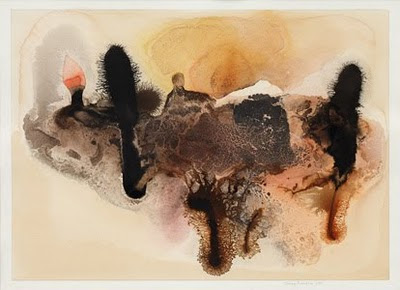When I think of watercolours, what immediately comes to mind are quaint, picturesque scenes of landscapes or flower gardens. However in the 18th Century, watercolours main role was that of scientific accuracy in capturing new, rare specimens integral to the study and understanding of the natural world. The paintings are extremely exquisite and intricate, succeeding to capture microscopic detail.
I especially am fond of Rachel Pedder-Smith’s ‘Bean painting: Specimens from the Leguminosae Family’, 2004. The different life stages of the beans reminded me of my current work on growth and transitions. Instead of being displayed in a documenting format, the artist has used an extremely playful, collective composition, which I believe animates the beans.

Bean painting: Specimens from the Leguminosae Family, 2004
Another section within the exhibition explored the use of watercolour in capturing the spirit of a place. I found this particular work interesting as watercolour has been used in a far more expressive way, reflecting the gritty, harsh qualities of the landscape as opposed to a pretty, wishy-washy painting. I suppose it also reminded me of home and before seeing this image I would never have thought it possible to use watercolour to capture elements of the rugged Welsh landscape.

John Piper
Glaciated Rocks, Nant Ffrancon, 1944
The exhibition investigates the array of tools used by watercolour artists. The conventional tools, brushes, paints and paper exploit and control its two most distinctive qualities, its liquidity and transparency. However we are also introduced to contemporary uses of watercolour with unusual tools, which challenge and reinvigorate the medium.
One of the most obscure tools used was Rebecca Salters’ incredible pattern composed of marks made by applying colour to a damp surface using a sharpened chopstick. Despite each mark spreading in a different way and leaving a unique flash of colour, the marks overall formed a definite, controlled pattern.
I particularly like this use of watercolour onto damp paper to encourage spread as there is something so organic and unexpected about the result. It also struck me as a possible way of drawing the mould in my current work. Jenny Franklin exploits this method in a considered way, which successfully reflects her subject-

Jenny Franklin
Scorched Earth, Regeneration, 2001
Another technique which sparked my imagination, was the removal of colour through scraping and scratching through a layer of applied watercolour paint to create a white line. This reminded me of my current experimental approach to life drawing- the use of applying charcoal and then removing it to add tone.
I learnt that the earliest watercolours were painted on vellum, fine animal skin burnished for a smooth surface. It is so interesting to look back and see the true extend to which we used animal products to aid our artistic creations and I was reminded of the whale bone corsets displayed by the Foundling Museum
War, despite being a horrendous atrocity led to some very interesting technical experiments within the medium. Artists used denser materials such as chalk and crayon to convey the shock and true extent of the horrors they witnessed.
Watercolour is also highly regarded for the ease at which it can be applied and its immediacy. Interestingly, many artists felt colour made the use of line unnecessary. This theory is demonstrated perfectly through David Austen’s playful people-

David Austen
Untitled, 2005
It resonated with the words of my life drawing tutor- Although outlining around the body may create a scientifically accurate drawing, it is the tonal qualities inside the outline that are really important when creating a representation of something.
I was extremely curious about Lucy Skaer’s graphic, eye catching painting and whether the negative space held more importance that the positive.

Lucy Skaer
Cell #1 (with rules and exceptions), 2005
The 20th Century saw the phenomenon of abstraction with images based on mass and tone rather than linear outline. This enabled watercolour to be used as a powerful tool for personal, emotive expression. Two paintings, which were in my opinion particularly inspiring were-
Patrick Heron
January 9: 1983:11, 1983
I feel this image captures the essence of sporadic mould growth. Unfortunately I cannot find an image of it so you will just have to visit the exhibition first hand!

Ian McKeever
Assembly Gouache, 2007
This exhibition taught me so much about a medium I feel I had taken for granted and lacked considerable knowledge about. I would certainly recommend it to anyone who is vaguely interested any form of painting or mark making. The diverse work demonstrates extreme skill and inspiring innovation. I have heard many talk of watercolour as something an artist does at the beginning and at the end of their career, a misconception that the medium can only be banal will be totally banished by this exhibition.

No comments:
Post a Comment